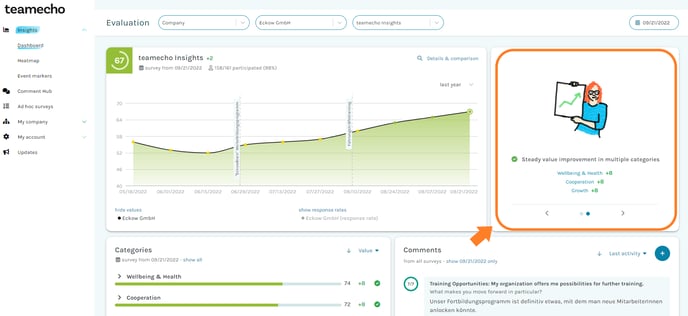What do I look for when analyzing teamecho Insights Light?
Are you using FreeTeam and curious about how to analyze your teamecho Insights Light results? Here you will find approaches to sustainably increase your team's motivation.
Attention: Are you using our full version of teamecho? Then click here to learn how the ten categories of teamecho Insights affect your team's motivation and health.
Motivated and healthy employees are the be-all and end-all of every high-performance team. teamecho Insights Light provides a compact overview of the most important factors influencing the motivation of your team.
The five categories of the Insights Light question set enable you to build up targeted resources and make the best use of existing strengths:
- Satisfaction & Motivation
- Cooperation
- Work Activity
- Growth
- Organizational Culture
If you want to learn more about FreeTeam by teamecho or the teamecho Insights Light question set, click here and check out this article.
Satisfaction & Motivation
As a first step, it's best to look at the results in the "Motivation & Satisfaction" category. Do you see high or rather low values here? Have the results changed since the last survey - and if so, in which direction?
Good values in this category mean that your team members are currently satisfied and motivated to work. The potential of your team seems to be well utilized at the moment - be happy about it and make sure together that it stays that way.
Critical values in this category indicate currently low motivation of the team members. It is now important to find out what the primary causes for this could be. Try to find these causes together, because this will make it easier for you to take measures to raise your motivation again.
Cooperation
Positive teamwork is one of the most important resources. It raises motivation and is one of the central prerequisites for sustained high performance and health. Appreciation within your team is also a very valuable resource. The values in this category will help you to work together towards positive teamwork.
Work Activity
Work motivation arises primarily when work tasks are varied and meaningful, freedom is allowed, requirements are clear, and the workload is easily manageable. The answers to the questions in this category provide information about some of the many factors that influence the activities of your team. In this way, you can identify possible obstacles and take targeted measures to promote the working environment and tasks.
Growth
Development opportunities have a direct influence on the commitment of your team. Only those who can develop themselves further and regularly experience a sense of achievement will be sustainably motivated and master even difficult tasks with self-confidence. This category helps you to recognize whether your team feels sufficiently challenged (but not overburdened) and also provides information about whether all team members have the opportunity to contribute their competencies and interests.
Organizational Culture
Shared values and an appreciative working atmosphere strengthen loyalty to the company. Your company's ecological and social commitment will also help your team to be enthusiastic about the workplace in the long term. The answers in this category show you where the strengths of your corporate culture lie and where you can develop together.
Interaction of categories - General trends
Best practice clearly shows that it's also important to look holistically at the trends and responses on your teamecho dashboard. The following questions will help you quickly identify your strengths and potential roadblocks:
- Are there categories or questions with particularly high values or positive comments? These are your teams' strengths or resources. Pay attention to them and draw on them, especially in stressful times.
- Are there categories or questions with low(er) values or critical feedback? These are the weak points or obstacles. We recommend finding actions for improvement.
- Are there categories or questions with varied distributions or very diverse answers? There are obviously different perceptions in the team and you should find out together what (not who!) is causing this.
- Have values improved since the last survey on the topic? Be happy about the upward trend - it's your shared achievement!
- Have values dropped? A decline can express a natural fluctuation or can be the beginning of a downward trend. It is important to remain attentive, to observe closely and, if necessary, to take action in due time.
- Are you surprised about certain survey results or comments that you did not expect? These show your previous "blind spots." We all have blind spots, but feedback from outside reduces them and enables us to get a more complete picture.
Helpful clues
The infobox in your teamecho dashboard helps you to identify relevant trends and to take a closer look at them. For example, you can find clues if the answers to a question are very different, or if there are steady upward or downward trends in a category.

Tip: In our article on the different visibility settings, you can also learn more about the individual areas of the teamecho Dashboard and which results go into which boxes.